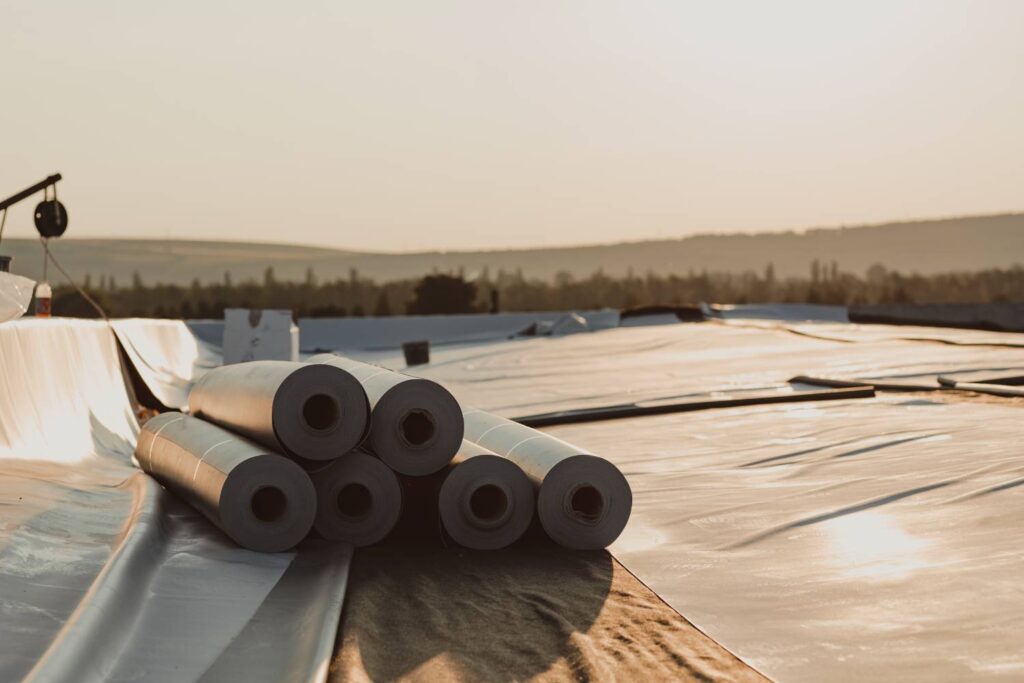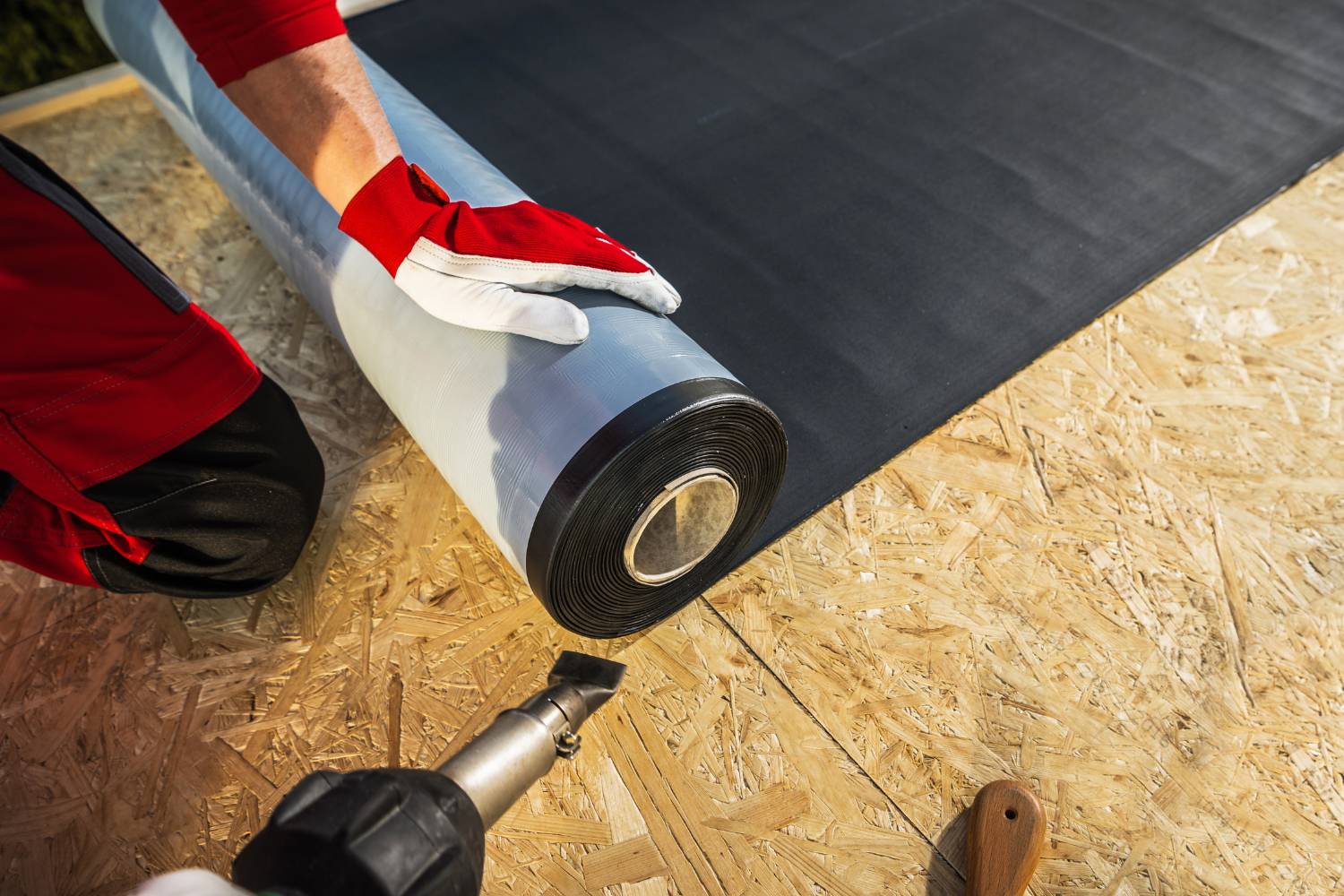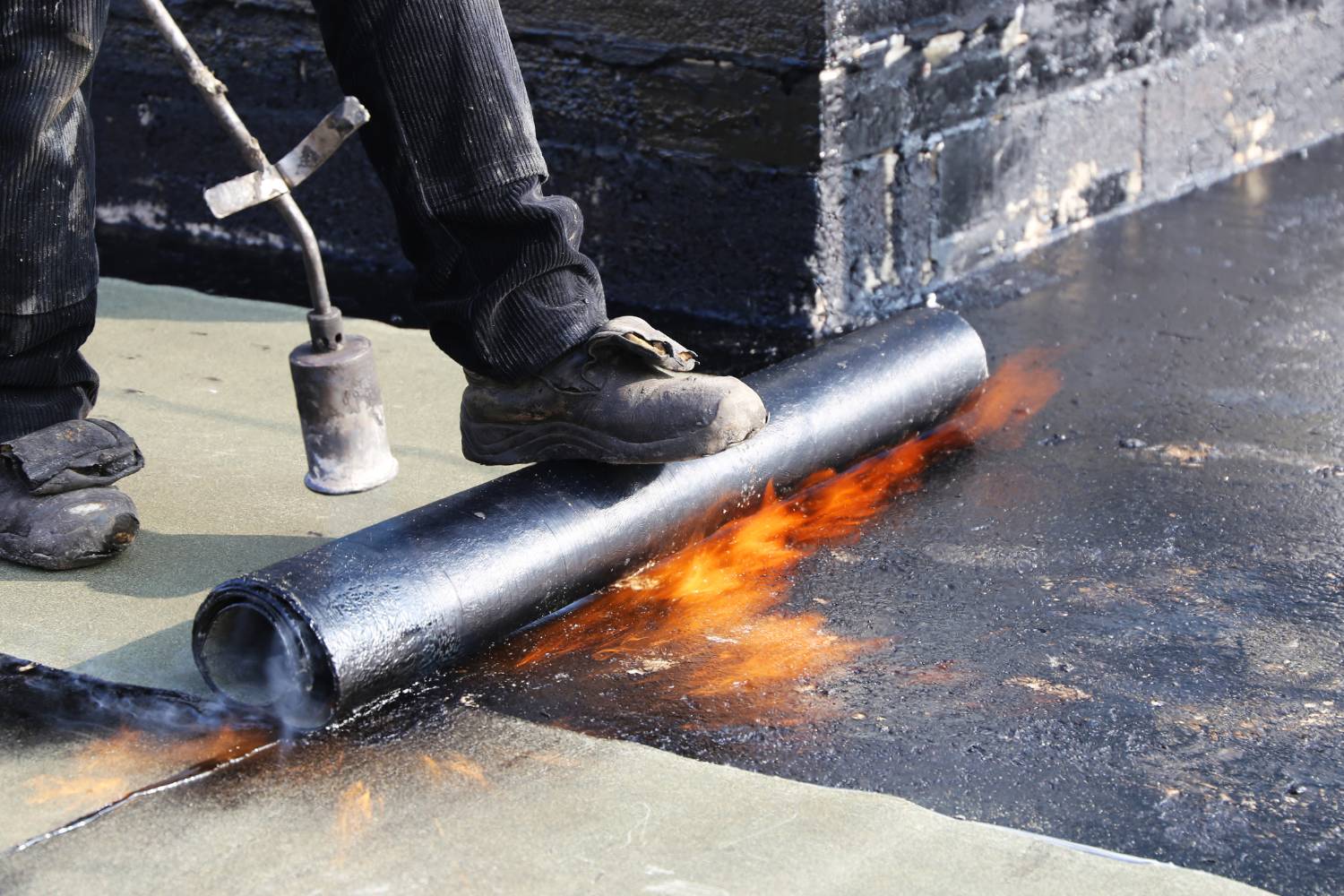Revitalising your roof not only enhances the overall appearance of your property but also significantly boosts its durability and efficiency.
In this post, we delve into two crucial techniques in roof restoration: membrane application and painting. Both methods play vital roles in ensuring your roof withstands the test of time and elements.
What Are the Benefits of Membrane Application?
Membrane application is a vital technique in roof restoration, offering a durable and effective solution to extend the lifespan of roofs. This method involves applying a membrane layer over the existing roof surface, providing protection against various environmental factors and preventing leaks. Here’s an in-depth look into membrane application in roof restoration.
Benefits Of Membrane Application
- Durability: Membrane roofs are known for their long-lasting properties, which can significantly extend the life of a roof. They provide a robust barrier against harsh weather conditions, including UV rays, rain, and snow.
- Energy Efficiency: Reflective membranes can reduce heat absorption, leading to lower cooling costs in buildings. This energy-efficient feature is particularly beneficial in warm climates.
- Leak Prevention: Membranes create a seamless and watertight barrier, which is essential for preventing leaks and water damage. This is especially critical for flat roofs, which are more susceptible to water pooling.
- Ease of Installation: Compared to complete roof replacements, membrane application is less invasive and quicker to install. This minimises disruption to building operations and can be more cost-effective.
Types Of Membrane Materials
- Thermoplastic Olefin (TPO): TPO membranes are popular due to their reflective properties and resistance to UV rays and chemicals. They are lightweight and offer strong seam strength.
- Ethylene Propylene Diene Monomer (EPDM): Known for its durability and flexibility, EPDM is a synthetic rubber membrane that performs well in various weather conditions. It is also resistant to ozone and UV radiation.
- Polyvinyl Chloride (PVC): PVC membranes are durable and resistant to chemicals, making them ideal for commercial roofs exposed to harsh conditions. They offer excellent fire resistance and strength.
- Fluid-Applied Membranes: These are seamless membranes applied as liquids, which then cure to form a durable, flexible coating. They are perfect for complex roof structures with numerous penetrations and irregular shapes.
How Is Membrane Applied To A Roof?
Roof membranes play a crucial role in ensuring the longevity and waterproofing of a roof. The application of these membranes requires careful planning and skilled execution to ensure effective protection. Here’s a detailed guide on how membranes are applied to roofs, incorporating various methods and considerations.
Preparation And Initial Steps
- Inspection and Cleaning: Before applying any membrane, the roof surface must be thoroughly inspected and cleaned. This involves removing debris, repairing any damage, and ensuring the surface is dry and smooth.
- Rigid Insulation Installation: A layer of rigid insulation is often installed over the roof deck to enhance energy efficiency and provide a stable surface for the membrane application.
Application Methods
- Mechanically Attached: This method involves securing the membrane with mechanical fasteners. It is commonly used for TPO and EPDM membranes. The membrane is rolled out over the insulation, and fasteners are driven through the membrane into the roof deck at designated intervals.
- Fully Adhered: In this method, the membrane is bonded to the substrate using adhesives. This provides a smooth, continuous surface with strong resistance to wind uplift. The adhesive is applied to both the substrate and the membrane, and the membrane is carefully laid into place and smoothed out to ensure full adhesion.
- Ballasted: This technique involves laying the membrane loosely over the insulation and then covering it with a layer of ballast (usually gravel or pavers). The weight of the ballast holds the membrane in place. This method is suitable for large, flat roofs and provides excellent protection against UV rays and physical damage.
- RhinoBond: This method uses induction welding to bond the membrane to plates fastened to the roof deck. This combines the benefits of mechanically attached and fully adhered systems, providing strong attachment without penetrating the membrane.
Specialised Application Techniques
- Torch-On Application: Torch-on application is used for modified bitumen membranes. The membrane has a thermofusible film on the underside that melts when heated with a torch, bonding the membrane to the substrate. This method requires skilled roofers due to the use of open flames.
- Hot Mopped: For some modified bitumen membranes, hot asphalt is used to bond the membrane to the substrate. The asphalt is applied at high temperatures, and the membrane is laid into the hot Cold Adhesive: Cold adhesive applications use specially formulated adhesives that do not require heating. The adhesive is spread onto the substrate, and the membrane is laid into it, providing a secure bond.
- Self-Adhered: Self-adhered membranes have a pre-applied adhesive layer covered with a release film. The film is removed as the membrane is unrolled, and the membrane is pressed into place, adhering to the substrate without additional adhesives.
Detail Work And Final Steps
- Flashings and Penetrations: The detail work around roof penetrations (such as HVAC units, skylights, and vents) and edges is critical. Special care is taken to ensure these areas are watertight. Flashings are installed and sealed to prevent leaks.
- Inspection and Quality Assurance: After the membrane is fully installed, a thorough inspection is conducted to ensure there are no gaps, wrinkles, or defects. Manufacturers may also inspect the installation as part of their warranty process.
Cold Weather Precautions
During cold weather, additional steps are taken to ensure the membrane remains flexible and adheres properly:
- Heated Storage: Membrane rolls are stored in heated areas before installation.
- Preheating: The membrane may be preheated with a torch to improve flexibility.
- Increased Adhesion: Extra care is taken with adhesives and asphalt to ensure proper bonding despite lower temperatures.
Why Is Painting Important In Roof Restoration?
Firstly, roof paint serves as a protective shield against various environmental elements such as UV rays, rain, and wind. This protective layer prevents damage from these elements, thereby reducing the wear and tear on the roof surface. For metal roofs, in particular, painting is crucial as it prevents rust and corrosion. The paint forms a barrier that blocks moisture and oxygen from reaching the metal, effectively preventing rust formation.
In addition to protection, painting enhances the aesthetic appeal of a building. A freshly painted roof dramatically improves the overall appearance, increasing the property’s curb appeal and potentially its market value. This visual improvement reflects positively on the general upkeep of the property, making it more attractive to potential buyers or tenants.
Modern roof paints are also designed with energy efficiency in mind. These paints often have reflective properties that help in reducing the amount of heat absorbed by the roof. As a result, indoor temperatures can be lower, reducing the need for air conditioning and leading to significant energy cost savings. This reflective property is particularly beneficial in hot climates where cooling costs can be substantial.
Regular painting and maintenance can substantially extend the lifespan of a roof. By protecting the roof surface from damage and deterioration, painting helps avoid costly repairs or premature roof replacements. This proactive approach to maintenance ensures that the roof remains in good condition for a longer period, providing ongoing protection for the building.
What Are The Steps For Painting A Roof?
Painting a roof is an effective way to enhance its appearance and extend its lifespan. The process requires careful preparation, the right materials, and proper techniques to ensure a durable and visually appealing finish. Here are the essential steps for painting a roof, compiled and refined from various sources.
Inspect And Repair The Roof
Before you start painting, thoroughly inspect the roof for any damage. Look for cracked, lifting, or missing shingles, tiles, or other roofing materials. Check for rust on metal roofs and signs of mould or algae growth. Repair any damages to ensure a smooth and even surface for painting. Replace damaged shingles or tiles, fix leaks, and clean rusted areas with primer and metal paint.
Clean And Sterilise The Roof
Cleaning the roof is crucial to ensure the paint adheres properly. Use a power washer to remove dirt, debris, moss, and algae from the roof. Start from the peak and work your way down to avoid lifting shingles or tiles. For stubborn mould and mildew, apply a biocidal wash and scrub the surface with a stiff brush. Allow the roof to dry completely before proceeding to the next step.
Apply A Sealant
Applying a sealant protects the roof from extreme weather conditions and UV rays. It also helps in reducing heat and cooling costs by reflecting sunlight. Choose a sealant suitable for your roof type—elastomeric or silicone sealants are popular for their waterproofing properties. Apply the sealant evenly across the roof, ensuring all areas are covered to enhance the durability of the paint.
Choose The Right Paint And Equipment
Selecting the appropriate paint is essential for a successful roof painting project. Water-based acrylic paints are recommended for their durability and UV resistance. They are suitable for various roofing materials, including concrete, terracotta tiles, and metal. You can apply the paint using different methods, such as spraying, brushing, or rolling. Airless paint sprayers are efficient for large areas, while brushes and rollers are better for detailed work.
Apply A Primer
Priming the roof ensures better adhesion of the paint and enhances the final colour. Use a water-based primer for non-metal roofs and a metal primer for metal surfaces. Apply a thin, even coat of primer across the entire roof and let it dry for at least two hours before painting. This step is crucial for achieving a uniform finish and long-lasting results.
Paint The Roof
Begin painting from the peak of the roof and work your way down. Use an airless paint sprayer for quick and even coverage, or apply the paint with brushes and rollers if you prefer more control. Hold the sprayer or brush 1–2 feet from the surface and apply the paint in smooth, overlapping strokes. Allow the first coat to dry for about two hours before applying a second coat. For a more vibrant colour, you can add a third coat after the second one dries.
Inspect And Touch Up
After the final coat of paint has dried, inspect the roof for any missed areas or uneven coverage. Use a brush or roller to touch up edges and tight corners to ensure a uniform appearance. Once satisfied with the coverage, let the paint cure completely before exposing the roof to weather conditions.
Safety Tips
- Always wear non-slip shoes and a safety harness when working on a roof to prevent falls.
- Use plastic sheets and painter's tape to cover vents, skylights, and other areas you don't want to paint.
- Work on a dry, sunny day to avoid moisture issues and ensure the paint dries properly.
How Do Membrane Application And Painting Work Together?
When membrane application and painting are combined, they create a synergistic effect that enhances the roof’s protection and longevity.
- Enhanced Waterproofing: While the membrane provides a primary waterproof barrier, the paint adds an extra layer of protection. This dual-layer system ensures superior waterproofing, significantly reducing the risk of leaks.
- Increased Durability: The membrane offers durability against harsh weather, and the paint protects the membrane itself from UV radiation and physical wear. This combination ensures that both the membrane and the underlying roof structure remain intact for a longer period.
- Improved Energy Efficiency: Reflective roof paints can work in conjunction with the membrane to reduce heat absorption. This results in a cooler roof surface, which can lower indoor temperatures and reduce energy consumption for cooling.
- Cost-Effectiveness: Using both membrane and paint in roof restoration can be more cost-effective in the long run. The enhanced protection and extended lifespan mean fewer repairs and replacements, saving money over time.
Conclusion
Membrane application and painting are indispensable techniques in roof restoration that provide robust protection and enhanced durability. By applying a membrane, you create a formidable barrier against environmental elements, ensuring your roof remains leak-free and energy-efficient. Meanwhile, painting offers an additional layer of defence, aesthetic appeal, and improved energy efficiency.
Together, these methods form a comprehensive approach to roof maintenance, extending the lifespan of your roof and reducing long-term costs. Embracing these practices not only safeguards your investment but also contributes to the overall sustainability and value of your property.
Frequently Asked Questions
The primary purpose of membrane application is to provide a durable, waterproof barrier that protects the roof from environmental factors such as UV rays, rain, and snow. This technique helps extend the lifespan of the roof by preventing leaks and reducing wear and tear.
A well-applied membrane roof can last between 20 to 30 years, depending on the type of membrane material used and the environmental conditions it is exposed to. Regular maintenance and inspections can further extend its lifespan.
Membrane application is versatile and can be applied to various types of roofs, including flat, low-slope, and pitched roofs. However, the specific type of membrane material chosen (such as TPO, EPDM, PVC, or fluid-applied membranes) should be appropriate for the roof’s structure and environmental conditions.
Painting is crucial in roof restoration as it provides an additional protective layer against environmental elements, enhances the roof's aesthetic appeal, and improves energy efficiency by reflecting sunlight. For metal roofs, painting also prevents rust and corrosion, significantly extending the roof’s lifespan.
Typically, a roof should be repainted every 5 to 10 years, depending on the quality of the paint, the environmental conditions, and the level of exposure to elements like UV rays and moisture. Regular inspections can help determine the optimal repainting schedule to ensure ongoing protection.


